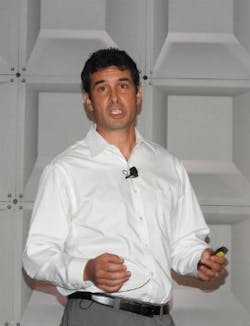“Let operations know that this is a project for the whole plant and they’re going to play a role in that.” Ocean Spray’s Bryan Graham discussed the company’s use of GE Digital tools to ramp up OEE at its plant in Middleboro, Mass.
Bryan Graham began his presentation with an apology for his “ridiculous” Rhode Island accent. But within a few minutes of his detailing the digitalization efforts he spearheads at Ocean Spray, any preconceived notions about this cranberry guy and his funny way of speaking were squashed.
He’s doing smart things.
An agricultural cooperative with 10 manufacturing plants that produces cranberry beverages and fruit snacks (Craisins), Ocean Spray has enjoyed massive growth over the past decade, now processing 200 million pounds of cranberries annually, producing 75 million pounds of dried, sweetened cranberries (up from 10 million pounds just a few years ago).
Graham works out of the Middleboro, Mass., plant. “It’s the largest cranberry-processing plant in the universe. At least I think that’s true,” he said with a chuckle.
In terms of digital transformation, Graham believes his team is “more toward the beginning of the road,” a self-estimation that might be too humble. Ocean Spray first adopted GE Digital’s Plant Applications software in 2007 to monitor performance and capabilities with their Craisin-packaging machines. “We were focused on improving overall equipment effectiveness (OEE) using the software’s efficiency management module,” he explained.
They used GE Digital Alliance Partner AutomaTech for implementation and support. “We really relied on them for guidance,” he said.
Lessons learned
Throughout the adoption and implementation process, Graham learned some lessons that he imparted to this audience:
- When possible, stick with an out-of-the-box solution.
- Get alignment and buy-in from stakeholders. Clarify who needs the data and what roles and responsibilities team members have related to it. “Let operations know that this is a project for the whole plant and they’re going to play a role in that.”
- Good data is critical to success. “It sounds simple, but people often need to be trained to develop usable data.” (Avoid the “garbage in, garbage out” quandary.)
- Share the tools early in the process. Make data easily accessible. Deliver the product on a silver platter. “Slap them in the face with the solution,” Graham said, garnering laughs.
- Don’t overcomplicate the solution. “There are times when 95% is better than trying to be 100%.”
The immediate results? Meh.
“Looking back, we recognized how engineers weren’t fully represented in the initiative,” said Graham. “And three-fourths of the team was IT who didn’t understand the key outputs we wanted to measure.”
The Ocean Spray team also learned that partial successes were, at the end of the day, still successes. “We got hung up on trying to find some 100% solution. Trying to solve every situation. We realized we needed to start by going after low-hanging fruit.”
Ha ha.
That initial effort was a bit of struggle. “It was an uphill battle to get people to see the value in the system,” admitted Graham. “There was a lack of interest in the analysis. The team didn’t value the information. I was the only one looking at data coming out of the systems.”
But the process-engineering manager’s trust in the tools was unwavering. “Failure is a good thing, right?”
A virtuous cycle
Graham knew the platform had value if it were properly implemented, so he trained himself on the system, focusing on throughput—processing more pounds of cranberries every day. He led weekly meetings to focus the team’s efforts and maintain commitment to the strategy. He developed a model in Plant Applications to map the entire production process. He utilized the iFIX add-in to generate custom SQL reports.
And, sure enough, the data began driving improvements. Graham discovered excessive downtime on conveyer lines, which was quickly remedied by changing the loading process. His team developed greater insights on machine uptime. Soon enough, a funny thing happened among previously disinterested coworkers—they began developing what Graham labels metric curiosity. “They wanted to see the data. They wanted this enhanced visualization so operators would get more interested in their performance.”
Wins prompted buy-in, which prompted more wins, which is reflected in that year-over-year growth the speaker cited early in his presentation.
Currently, according to Graham, Ocean Spray is plateauing at 75 million pounds of processed cranberries per year. It’s impossible to maintain the growth they’ve experienced in recent years, so the collective is looking internally to determine how to make processes more efficient courtesy of digital tools. Automated efforts mean that resources are freed up to explore ways to “do what we do better.”
One target—modernizing electronic data capture. Graham, himself, is baffled by the current machine-failure-monitoring system that requires supervisors to write the cause of failure on a whiteboard, photograph the board at the end of the day, then email that image to the group. He’s still not sure where these photos end up but he knows there’s a better, digital solution.
“I am excited to make that happen for our company,” he said.
That sounds pretty smart, no matter how you say it.





